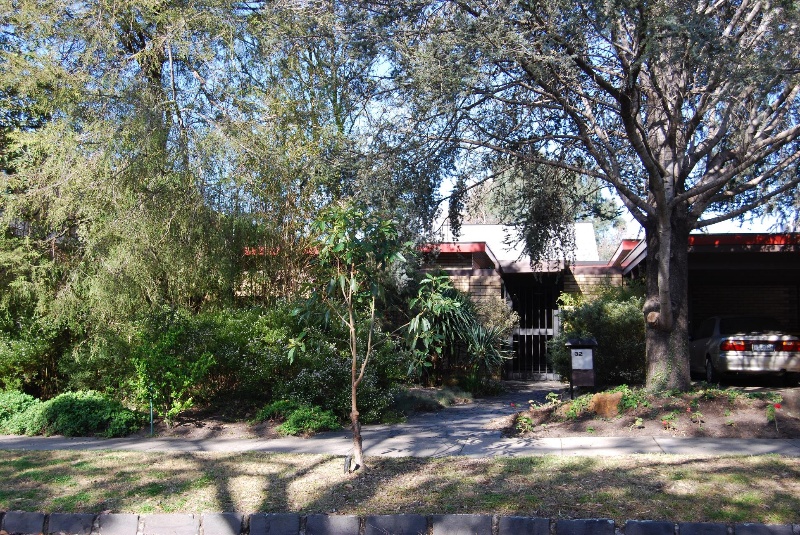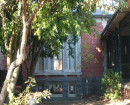ERNEST FOOKS HOUSE
32 HOWITT ROAD CAULFIELD NORTH, GLEN EIRA CITY
-
Add to tour
You must log in to do that.
-
Share
-
Shortlist place
You must log in to do that.
- Download report



Statement of Significance
STATEMENT OF CULTURAL HERITAGE SIGNIFICANCE
What is significant?
The residence at 32 Howitt Road, Caulfield North was designed in 1964 by Dr Ernest Fooks for himself and his wife Noemi, and completed in 1966. It was built by S&S Susskind Pty Ltd. Ernest Fuchs was born in Bratislava, Czechoslovakia on 6 October 1906 and was educated in Vienna, completing a degree in architecture and a doctorate in town planning. After escaping Europe's increasing anti-Semitism, he married Noemi in Canada before migrating to Australia, arriving in Melbourne in May 1939. He initially worked for the Housing Commission of Victoria before becoming the first lecturer in town planning at Melbourne Technical College (now RMIT). He changed his name to Fooks on becoming an Australian citizen in 1945. Dr Ernest Fooks established his architectural practice in 1948, which was highly successful, and he completed over forty blocks of flats, numerous houses, as well as commercial and education buildings. He published widely on urban design and town planning, and was also an accomplished artist, holding exhibitions over the period from 1944 to 1984. He was also involved with his wife Noemi in community life including the Jewish service organisation B'nai B'rith, and his prominence within the Jewish community was recognised through his commission to design the National Jewish Memorial Centre and Community FAciltiy in Canberra, completed in 1971. He died in 1985. Despite his prolific output in both built work and publishing, and coverage of his work in magazines such as Australian House and Garden, his work was not widely acknowledged in general architectural circles until recently.
The house is single storey, face brick, with a predominantly flat roof, punctured with a slate-clad mansard roof section providing north facing clerestory lighting. Deceptively unassuming from the street, it is a complex, multi-layered spatial composition, in a fully designed landscape. The flow from the front to the rear is through a series of spaces which vary in their degree of enclosure, entering through a courtyard with roof over the path only, through the main entrance into entry foyer with cloak and powder rooms, through to the picture gallery, which opens into the main living space with dramatic upsweeping timber battened ceiling. The design is enriched by the complexity and variety of finishes, with the floors of the different spaces changing from terracotta tiles entry foyer, to off-white terrazzo tiles of picture gallery, the living and dining spaces, herringbone patterned parquetry of the den and carpet in the bedrooms. The oiled teak built-in joinery throughout the house is carefully detailed and exquisitely crafted. The walls vary between face brick given strong horizontality with struck horizontal joints, and Japanese straw-coloured fabric-like wallpaper, also used for some of the built-in cupboard doors. There is a strong Japanese influence throughout the house and garden, from the landscaping of the front garden with its winding path of slate slabs with dark grey pebbles between, curved broken brick wall, pebbled courtyards, to the folding and sliding finely detailed timber screens inside, which separate the picture gallery, living, dining and den spaces.
The house including all built in joinery and light fittings, and its setting including all the hard landscaping are completely intact, and the garden retains its original plantings.
How is it significant?
The Ernest Fooks House is of architectural, aesthetic and historical significance to the state of Victoria.
Why is it significant?
The Ernest Fooks House is of architectural and aesthetic significance as an intact, individual, and highly creative work combining analytical planning, aspects of Scandinavian and European modern design while incorporating principles of traditional Japanese architecture. It represents the most architecturally resolved of Fook's domestic designs, being a complex and carefully detailed multi-layered spatial composition in a fully designed landscape.
The Ernest Fooks House is also of architectural significance for its high level of craftsmanship in the joinery and finishes throughout the house, from the folding and sliding screens to built-in joinery items.
The house is of historical significance for its special association with Dr Ernest Fooks, a highly talented, progressive, European-trained emigre architect who made an important contribution to the architecture, town planning, education of architects and town planners, and to the cultural life of Melbourne in the decades immediately following the Second World War.
-
-
ERNEST FOOKS HOUSE - Plaque Citation
Designed in 1964 by Dr Ernest Fooks for himself and his wife Noemi, this highly creative house combines aspects of Scandinavian and European modern design while incorporating principles of traditional Japanese architecture.
ERNEST FOOKS HOUSE - Assessment Against Criteria
Assessment Against Criteria:
a. Importance to the course, or pattern, of Victoria's cultural history
b. Possession of uncommon, rare or endangered aspects of Victoria's cultural history.
c. Potential to yield information that will contribute to an understanding of Victoria's cultural history.
d. Importance in demonstrating the principal characteristics of a class of cultural places or environments.
e. Importance in exhibiting particular aesthetic characteristics.
The Ernest Fooks house is important is exhibiting architectural and aesthetic significance as an intact, individual, and highly creative work combining analytical planning, aspects of Scandinavian and European modern design while incorporating principles of traditional Japanese architecture. It represents the most architecturally resolved of Fook's domestic designs, being a complex and carefully detailed multi-layered spatial composition in a fully designed landscape.
f. Importance in demonstrating a high degree of creative or technical achievement at a particular period.
The Ernest Fooks House demonstrates a high degree of creative accomplishment as a highly refined, individual and masterful work which is deceptively unassuming from the street.
The Ernest Fooks House demonstrates a high degree of creative accomplishment in the craftsmanship in the joinery and finishes throughout the house, from the folding and sliding screens to built-in joinery items.
g. Strong or special association with a particular community or cultural group for social, cultural or spiritual reasons. This includes the significance of a place to Indigenous peoples as part of their continuing and developing cultural traditions.
h. Special association with the life or works of a person, or group of persons, of importance in Victoria's history.
The house has special association with Dr Ernest Fooks, as the house designed for himself and his wife Noemi. Dr Ernest Fooks was one of a number of highly talented, progressive, European-trained emigre architects who made an important contribution to the architecture, town planning, education of architects and town planners, and to the cultural life of Melbourne in the decades immediately following the Second World War.
ERNEST FOOKS HOUSE - Permit Exemptions
General Exemptions:General exemptions apply to all places and objects included in the Victorian Heritage Register (VHR). General exemptions have been designed to allow everyday activities, maintenance and changes to your property, which don’t harm its cultural heritage significance, to proceed without the need to obtain approvals under the Heritage Act 2017.Places of worship: In some circumstances, you can alter a place of worship to accommodate religious practices without a permit, but you must notify the Executive Director of Heritage Victoria before you start the works or activities at least 20 business days before the works or activities are to commence.Subdivision/consolidation: Permit exemptions exist for some subdivisions and consolidations. If the subdivision or consolidation is in accordance with a planning permit granted under Part 4 of the Planning and Environment Act 1987 and the application for the planning permit was referred to the Executive Director of Heritage Victoria as a determining referral authority, a permit is not required.Specific exemptions may also apply to your registered place or object. If applicable, these are listed below. Specific exemptions are tailored to the conservation and management needs of an individual registered place or object and set out works and activities that are exempt from the requirements of a permit. Specific exemptions prevail if they conflict with general exemptions. Find out more about heritage permit exemptions here.Specific Exemptions:General Conditions: 1. All exempted alterations are to be planned and carried out in a manner which prevents damage to the fabric of the registered place or object. General Conditions: 2. Should it become apparent during further inspection or the carrying out of works that original or previously hidden or inaccessible details of the place or object are revealed which relate to the significance of the place or object, then the exemption covering such works shall cease and Heritage Victoria shall be notified as soon as possible. Note: All archaeological places have the potential to contain significant sub-surface artefacts and other remains. In most cases it will be necessary to obtain approval from the Executive Director, Heritage Victoria before the undertaking any works that have a significant sub-surface component. General Conditions: 3. If there is a conservation policy and plan endorsed by the Executive Director, all works shall be in accordance with it. Note: The existence of a Conservation Management Plan or a Heritage Action Plan endorsed by the Executive Director, Heritage Victoria provides guidance for the management of the heritage values associated with the site. It may not be necessary to obtain a heritage permit for certain works specified in the management plan. General Conditions: 4. Nothing in this determination prevents the Executive Director from amending or rescinding all or any of the permit exemptions. General Conditions: 5. Nothing in this determination exempts owners or their agents from the responsibility to seek relevant planning or building permits from the responsible authorities where applicable. Minor Works : Note: Any Minor Works that in the opinion of the Executive Director will not adversely affect the heritage significance of the place may be exempt from the permit requirements of the Heritage Act. A person proposing to undertake minor works may submit a proposal to the Executive Director. If the Executive Director is satisfied that the proposed works will not adversely affect the heritage values of the site, the applicant may be exempted from the requirement to obtain a heritage permit. If an applicant is uncertain whether a heritage permit is required, it is recommended that the permits co-ordinator be contacted.ERNEST FOOKS HOUSE - Permit Exemption Policy
The Ernest Fooks House is significant because it is compeletely intact. The exterior retains its face brickwork exterior walls, including pointing, and original hard landscaping and major plantings. The interior retains all orignal wall and floor finishes, including face brickwork and pointing, oiled teak built-in furniture and and light fittings. Any alterations to the exterior or interior should be carefully considered and therefore no site specific permit exemptions are recommended.
-
-
-
-
-
ROSECRADDOCK
 Victorian Heritage Register H0589
Victorian Heritage Register H0589 -
LABASSA
 Victorian Heritage Register H0135
Victorian Heritage Register H0135 -
TRAM VERANDAH SHELTER
 Victorian Heritage Register H0174
Victorian Heritage Register H0174
-
1 Miller Street
 Yarra City
Yarra City -
1-3 Rowena Parade
 Yarra City
Yarra City
-
-












